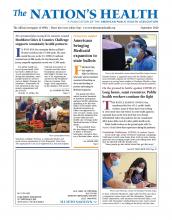
Photo by Tero Vesalainen, courtesy iStockphoto
Screens are part of everyday life. From home televisions and desktop computers to smartphones and laptops, you might routinely be viewing multiple screens a day.
While screen time can be beneficial — such as when it’s used for learning, exercising or to connect with far-off friends and family — spending too much time indoors looking at screens can be hard on your eyes.
One problem can be digital eye strain, a type of eye fatigue that is caused by screens. If you spend a lot of time using your phone, tablet or other device and have blurry vision, dry eyes, headaches or teary eyes, you may have digital eye strain.
Eye strain is caused in part by reduced blinking. When you’re looking at a screen or something up close for a long period of time, you stop blinking naturally, according to Raj Maturi, MD, an ophthalmologist and assistant professor at Indiana University. Your eyes then dry out, causing discomfort.
To prevent digital eye strain, the American Academy of Ophthalmology recommends the 20-20-20 rule: For every 20 minutes looking at a screen, look at something that is 20 feet away for at least 20 seconds. The exercise allows your eyes to rest and reset.
“The good news is that you really can’t hurt your eyes permanently just because you use screens,” Maturi says.
Other simple ways to reduce eye strain include adjusting your monitor so you’re looking slightly downward. Try keeping a bottle of eye drops or artificial tears nearby just in case your eyes dry out. A humidifier can also help keep your eyes feeling more fresh.
If you frequently have headaches that feel like throbbing behind your eyes, it may be a sign that you need to change how you work, Maturi notes.
“Listening to our bodies may be the most helpful way to know that you need to make a change,” he says.
Spending a lot of time using screens, particularly if you view them at night, can also interfere with your sleep. Screens give off a lot of blue light. This kind of light tells your brain to be alert, even if you're getting ready for bed. It’s the same sort of effect that sunlight has. So spending too much time with screens at night can mess with your sleep cycle.
The key is to cut down the amount of blue light you’re seeing as you get closer to bedtime. Ideally, you should stop using screens altogether at least a half hour before going to bed. But if you can’t, check the settings on your device.
“Computers and smartphones generally have a ‘dark’ or ‘night’ mode setting that will cut out a lot of the blue light displayed on the screen,” Maturi says.
Another issue with screen time is inactivity. As people increase their screen time, they can lose track of how long they are sitting without moving. The Centers for Disease Control and Prevention recommends taking a five-minute break every hour. If you can’t remember, set a timer.
Your breaks can be as easy as standing and stretching or taking a walk around the room. In addition to stretching your muscles, taking a break can give your eyes a rest.
“People need to be more cautious,” Maturi says. “If you’re sitting a lot in the same position, looking at the same near target for a long time, you’re going to have problems.”
What about your vision?
Many people have nearsightedness, which is the inability to clearly see things that are far away. Scientists are still trying to decide if there is a connection between nearsightedness and screen time. Research has been mixed.
People who have nearsightedness can wear glasses or contact lenses to see better, or even consider corrective surgery. But there may also be ways to help slow it from worsening. Spending more time being active outdoors is beneficial, the American Academy of Ophthalmology says. It’s also a good idea to bring more natural light indoors.
For more information on eyes and safe screen use, visit www.aao.org
- Copyright The Nation’s Health, American Public Health Association









